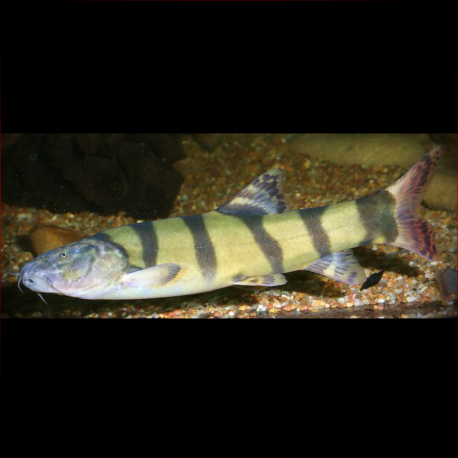More info
Datasheet
| Minimum Tank Size | 2000 litres / 528.34 US gallons |
| Maximum Size | 50.0cm / 19.69inches |
| Temperature | 15°C / 59.00°F - 24°C / 75.20°F |
| Hardness | 5.04dgH / 90ppm - 20.00dgH / 357ppm |
| pH | 6.5-7.5 |
General Description
The Imperial Flower Loach, scientifically known as Leptobotia Elongata, belongs to the family Botiidae within the classification order of Cypriniformes. This species, also called the "royal clown" loach, is rare in the aquarium trade and is native to the middle and upper sections of the Yangtze River in China.
Aquarium Setup
In a captive environment, the Imperial Flower Loach should ideally be housed in a large tank with a minimum capacity of 2000 litres designed to mimic a flowing stream. The tank setup should feature a substrate of rocks, gravel, and water-worn boulders, along with driftwood roots, branches, and PVC piping for cover. Hardy plant species like Microsorum, Bolbitis, or Anubias can be added, and bright lighting is recommended for aufwuchs growth. Clean, well-oxygenated water with a pH of 6.5-7.5 and a temperature range of 15-24°C is crucial for their well-being.
Behaviour
Imperial Flower Loaches are not outwardly aggressive towards smaller fish but their predatory nature and adult size limit suitable tank companions. They exhibit social behavior, forming complex social hierarchies, suggesting that keeping 3-4 individuals together is advisable. In larger aquaria, compatible tankmates may include riverine cyprinids like Balantiocheilos melanopterus, Barbonymus, and Hampala, although such setups are uncommon among private aquarists.
Feeding and Diet
The Imperial Flower Loach is a benthic predator that feeds on insects, crustaceans, and smaller fish. Their diet may consist of live or frozen bloodworms, Tubifex, chopped shellfish, earthworms, sinking dried foods, prawns, mussels, and fish like trout or salmon. Avoid feeding live fish from aquarium shops due to disease risks, and instead opt for a homemade gel-based recipe high in carotenoids to enhance body coloration.
Reproduction & Dimorphism
Reproduction of the Imperial Flower Loach has not been documented in aquarium settings but Chinese farms have produced them using hormones. In the wild, they are migratory seasonal spawners, a behavior disrupted by dam construction. Sexual dimorphism is unknown, but females are presumed to be heavier-bodied once sexually mature.
Habitat and Distribution
In their natural habitat, Imperial Flower Loaches are predominantly found in riverine environments with clear, well-oxygenated, running water and rocky/gravel substrates. They inhabit headwater streams, boulder-filled areas, and larger river channels, with a declining population due to pollution, habitat degradation, and overfishing. Their distribution ranges from the Yangtze River in China to the Lo River drainage in northern Vietnam.

